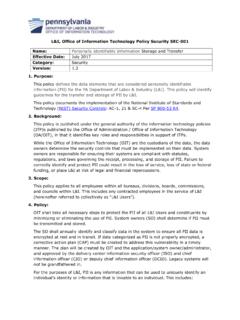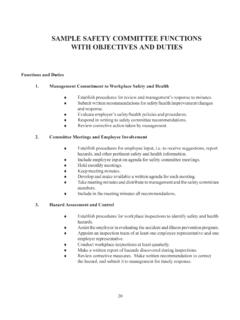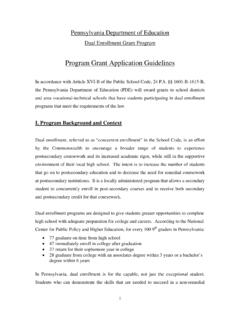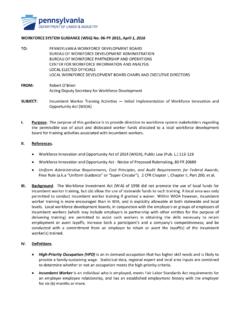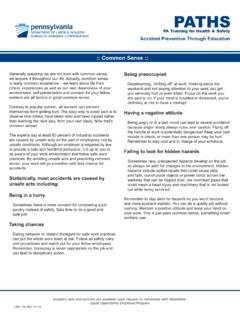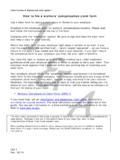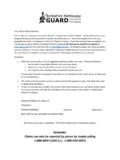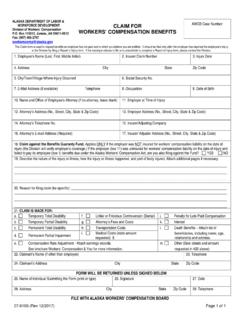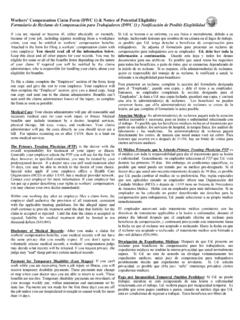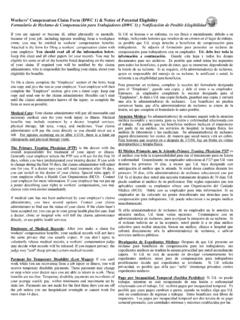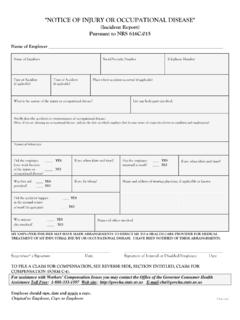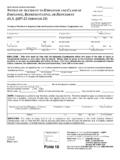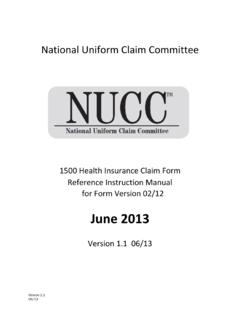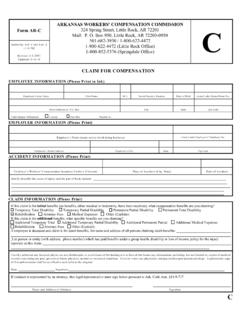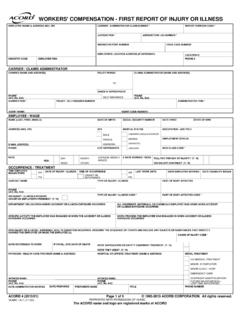Transcription of The Flow of a Pennsylvania Workers’ Compensation Claim
1 3 Employers are required to post form LIBC-500, Remember: It is Important to Tell Your Employer About Your Injury, to inform employees of the name, address and phone number of their workers Compensation insurance company, their third-party administrator or internal workers Compensation contact employee injury is to be reported to the employer within 21 days; if not reported within 120 days from the date of injury or having knowledge of a work-related disease, no Compensation is allowed (except for cases involving progressive diseases).Employers are required to immediately report all employee injuries to their insurer or, if self-insured, to report them to the person responsible for management of the employer s workers Compensation program.
2 Employers are also required to file a First Report of Injury via EDI transaction in the IAIABC Claims Release 3 format with the Bureau of Workers Compensation within 48 hours for every injury resulting in death, and within seven days for all other injuries that result in disability lasting more than a day, shift or turn of 21 days from the date the employee provides notification of an injury, the employer/carrier denies liability and issues a Notice of Workers Compensation Denial (LIBC-496) to the employee; the Denial and appropriate EDI transaction must also be filed with the Bureau of Workers Compensation . The Claim is now closed, though the injured worker can seek legal advice to pursue a Claim through the litigation system.
3 See the Flow of a Litigated Workers Compensation Claim on page 4 for more 21 days from the date the employee provides notification of an injury, the employer/carrier issues a Notice of Temporary Compensation Payable (LIBC-501) to extend the investigation period to 90 days before accepting or denying full liability for the injury. This paper form and EDI transaction must be filed with the bureau along with the Statement of Wages (below).When the employer elects to stop paying the injured worker temporary Compensation , a Notice Stopping Temporary Compensation (LIBC-502) is completed. The employer must then issue either a Notice of Workers Compensation Denial, Notice of Compensation Payable or Agreement for Compensation to the injured worker as well as the appropriate EDI transaction with the bureau within the 90-day temporary 21 days from the date the employee provides notification of an injury, the employer/carrier accepts liability for the injury and issues a Notice of Compensation Payable (LIBC-495) to the injured worker .
4 The Notice of Compensation Payable, the appropriate EDI transaction and Statement of Wages must be filed with the bureau. Within 21 days from the date the employee provides notification of an injury, the employer/carrier accepts liability for the injury and issues an Agreement for Compensation (LIBC-336) to the injured worker . The appropriate EDI transaction, the Agreement for Compensation in paper form and the Statement of Wages must be filed with the must use the Statement of Wages (LIBC-494C) to calculate the employee s wages and should send a copy to the injured employee. This form must be submitted to the an injured worker returns to their previous employment, the insurer may file a Notice of Suspension or Modification (LIBC-751) within seven days of the injured party s return to work along with the appropriate EDI transaction.
5 Additional LIBC-751s for further modifications may be filed as necessary within seven days of the modification insurer must provide the injured worker with the LIBC-392A, Final Statement of Account of Compensation Paid and submit the appropriate EDI transaction to the bureau after the final payment of insurer must provide the injured worker with a Supplemental Agreement (LIBC-337) to alter the worker s benefits and submit the appropriate EDI transaction and paper form to the bureau. The insurer must provide the injured worker with the LIBC-392A, Final Statement of Account of Compensation Paid and submit the appropriate EDI transaction to the bureau after the final payment of Compensation .
6 The Final Receipt (LIBC-340) is filed when an injured worker s benefits terminate. The insurer must provide the injured worker with the Final Receipt and submit the appropriate EDI transaction to the bureau. The worker has three years from the date of the last received workers Compensation check to file a Claim petition contesting the termination of Flow of a Pennsylvania Workers Compensation ClaimSupplemental Agreementfor CompensationFinal Statement of Accountof Compensation PaidAgreement to Stop WeeklyWC Payments(Final Receipt)Final Statement of Accountof Compensation PaidStatement of WagesNotice of Suspension or ModificationAgreement for CompensationNotice of Compensation PayableNotice Stopping Temporary CompensationNotice of TemporaryCompensation PayableNotice of WC DenialFirst Report of InjuryInjuryNotice of Injury4 The Flow of a Pennsylvania Workers Compensation Claim (Litigated)Employers are required to post form LIBC-500, Remember.
7 It is Important to Tell Your Employer About Your Injury, to inform employees of the name, address and phone number of their workers Compensation insurance company, their third-party administrator or internal workers Compensation contact employee injury is to be reported to the employer within 21 days; if not reported within 120 days from the date of injury or having knowledge of a work-related disease, no Compensation is allowed (except for cases involving progressive diseases).Employers are required to immediately report all employee injuries to their insurer or, if self-insured, to report them to the person responsible for management of the employer s workers Compensation program.
8 Employers are also required to file a First Report of Injury (formerly the Employer s Report of Occupational Injury or Disease) with the Bureau of Workers Compensation within 48 hours for every injury resulting in death, and within seven days for all other injuries that result in disability lasting more than a day, shift or turn of work. This document must be submitted 21 days from the date the employee provides notification of an injury, the employer/carrier accepts liability for the injury and issues a Notice of Workers Compensation Payable, a Notice of Temporary Compensation Payable or an Agreement for Compensation to the employee. These paper form and EDI transactions must also be filed with the Bureau of Workers Compensation .
9 See the Flow of a Pennsylvania Workers Compensation Claim on page 3 for more detailed 21 days from the date the employee provides notification of an injury, the employer/carrier denies liability and issues a Notice of Workers Compensation Denial to the employee; the Denial and appropriate EDI transaction must also be filed with the , the employee has three years from the date of injury to file a Claim Petition (LIBC-362). The law also provides that injured workers may reopen their Claim within three years from the last date an indemnity payment was made on a Claim . (Mere paying of medical benefits would not be the same as reopening the Claim .) Workers Compensation petitions are normally assigned to a workers Compensation judge according to the county in which the employee lives.
10 A Notice of Assignment is issued to the parties advising them as to which judge is assigned to the matter. Once assigned, all parties involved in the case are notified as to the date, time and place of workers Compensation judge hears and receives evidence presented by both the defendant (employer/insurer) and claimant at one or more hearings that may be extended by the need to obtain medical evidence and hear other workers Compensation judge will schedule the case for mediation, unless the judge concludes it would be futile. If this mediation does not take place or lead to settlement, the parties may at any time ask for an informal conference or settlement conference with a workers Compensation written decision is circulated to involved parties after a case is closed (all evidence has been submitted and the judge has everything necessary to render a decision).



